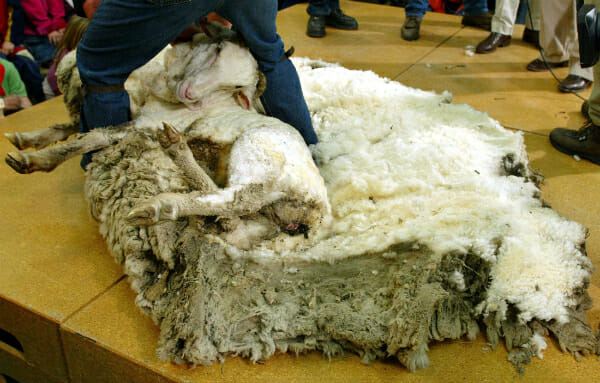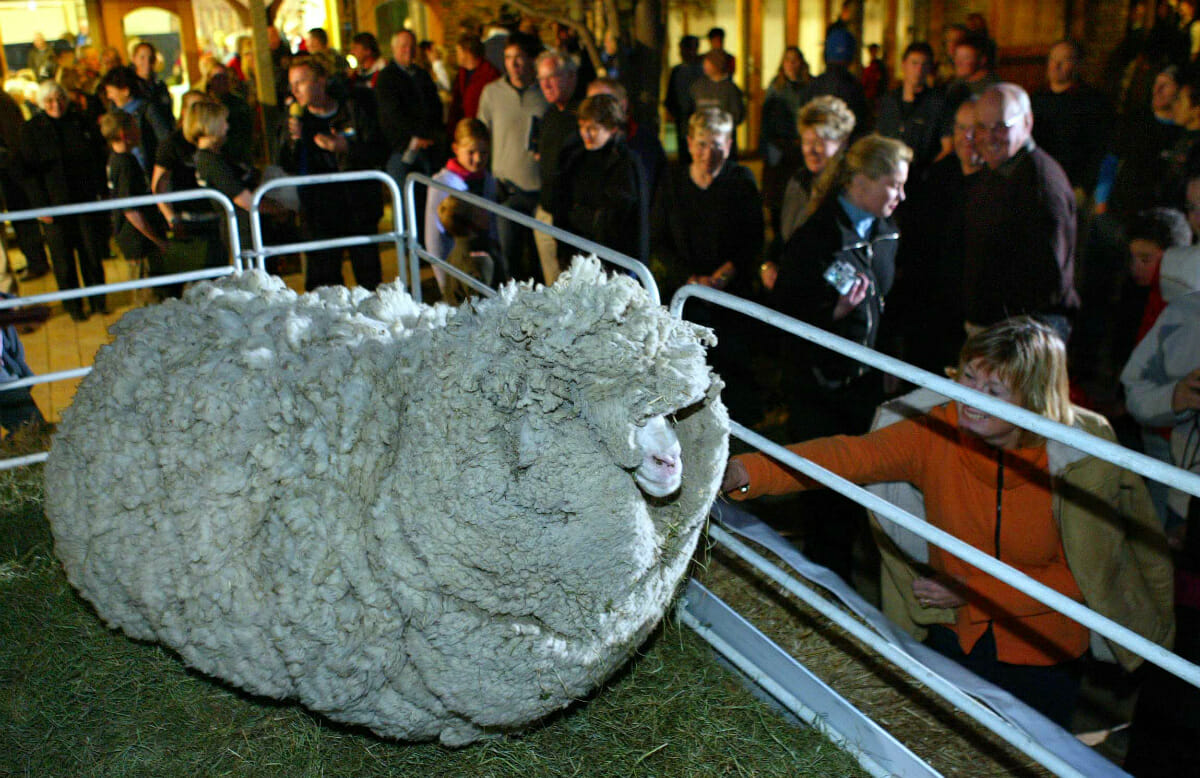Will a Sheep’s Wool Grow Forever?
If a sheep is left unshorn, will its wool grow forever? Is that healthy? Is this a glitch in the (wooly) fabric of evolution?
Take a moment to drink in the glory of Shrek the Sheep. Shrek really, really, really did not like getting his hair cut. So for six years, this New Zealand libertarian managed to avoid spring shearings by hiding in a cave.
By the time he was found in 2004, his owners couldn’t even tell he was a sheep. “He looked like some biblical creature,” John Perriam told the BBC. Or, to quote a member of Modern Farmer‘s editorial team, “Someone help that sheep, he is being eaten by some kind of dirty monster.”
When Shrek was eventually sheared (because man always triumphs over sheep), there was enough wool to produce 20 men’s suits. Just an abnormal, excessive, downright insane amount of wool. Which led us to some basic questions: If a sheep is left unshorn, will its wool grow forever? Is that healthy? Is this a glitch in the (wooly) fabric of evolution?
We turned to Dave Thomas, head of sheep studies at the University of Wisconsin, Madison, who patiently answered all our pressing sheep questions.
Modern Farmer: Let’s get right down to business. Will wool just keep growing and growing if humans don’t cut it off?
Dave Thomas: For domestic sheep like the Merino [Shrek’s breed], the answer is yes.
MF: So domestic sheep have evolved based on the way we groom them?
DT: That’s right. Primitive sheep like Bighorns in the West still shed most of their wool every year. And domestic sheep, the ones raised primarily for their meat, will do some shedding. But for the majority of sheep, there is continual, year-round wool growth.
MF: Shrek was obviously an extreme case, yes?
DT: It’s very rare for wool to get that long. We do hear stories from people with just a few sheep at home, who have a hard time finding a shearer. [Ed note: See related Modern Farmer story for more on that issue.] They’ll often let ’em go for two or three years.

MF: Are there potential health issues?
DT: Full fleece can be bad in very hot weather, sometimes leading to heat stress. There are also mobility issues: if a sheep with long wool lies down on a heavy incline, it can be impossible for them to roll off of their backs. In extreme cases, they can die.
MF: That’s wild. What about vision? It looked like Shrek would have a hard time seeing through that mess.
DT: That is what you would call “wool-blind,” when the sheep’s vision is actually impaired.
MF: Do most sheep hate getting sheared?
DT: Just like going to the dentist, nobody loves getting sheared. If only sheep knew how much better it makes things in the long run! It’s funny: young sheep will fight against shearing pretty hard, struggling and kicking. But older sheep are pretty docile – they know the routine, it’s not such a big deal. A good shearer will be done in three to four minutes, with no pain at all.
R.I.P. Shrek. Mourn ya ’til we join ya.
Follow us

This work is licensed under a Creative Commons Attribution-NoDerivatives 4.0 International License.
Want to republish a Modern Farmer story?
We are happy for Modern Farmer stories to be shared, and encourage you to republish our articles for your audience. When doing so, we ask that you follow these guidelines:
Please credit us and our writers
For the author byline, please use “Author Name, Modern Farmer.” At the top of our stories, if on the web, please include this text and link: “This story was originally published by Modern Farmer.”
Please make sure to include a link back to either our home page or the article URL.
At the bottom of the story, please include the following text:
“Modern Farmer is a nonprofit initiative dedicated to raising awareness and catalyzing action at the intersection of food, agriculture, and society. Read more at <link>Modern Farmer</link>.”
Use our widget
We’d like to be able to track our stories, so we ask that if you republish our content, you do so using our widget (located on the left hand side of the article). The HTML code has a built-in tracker that tells us the data and domain where the story was published, as well as view counts.
Check the image requirements
It’s your responsibility to confirm you're licensed to republish images in our articles. Some images, such as those from commercial providers, don't allow their images to be republished without permission or payment. Copyright terms are generally listed in the image caption and attribution. You are welcome to omit our images or substitute with your own. Charts and interactive graphics follow the same rules.
Don’t change too much. Or, ask us first.
Articles must be republished in their entirety. It’s okay to change references to time (“today” to “yesterday”) or location (“Iowa City, IA” to “here”). But please keep everything else the same.
If you feel strongly that a more material edit needs to be made, get in touch with us at [email protected]. We’re happy to discuss it with the original author, but we must have prior approval for changes before publication.
Special cases
Extracts. You may run the first few lines or paragraphs of the article and then say: “Read the full article at Modern Farmer” with a link back to the original article.
Quotes. You may quote authors provided you include a link back to the article URL.
Translations. These require writer approval. To inquire about translation of a Modern Farmer article, contact us at [email protected]
Signed consent / copyright release forms. These are not required, provided you are following these guidelines.
Print. Articles can be republished in print under these same rules, with the exception that you do not need to include the links.
Tag us
When sharing the story on social media, please tag us using the following: - Twitter (@ModFarm) - Facebook (@ModernFarmerMedia) - Instagram (@modfarm)
Use our content respectfully
Modern Farmer is a nonprofit and as such we share our content for free and in good faith in order to reach new audiences. Respectfully,
No selling ads against our stories. It’s okay to put our stories on pages with ads.
Don’t republish our material wholesale, or automatically; you need to select stories to be republished individually.
You have no rights to sell, license, syndicate, or otherwise represent yourself as the authorized owner of our material to any third parties. This means that you cannot actively publish or submit our work for syndication to third party platforms or apps like Apple News or Google News. We understand that publishers cannot fully control when certain third parties automatically summarize or crawl content from publishers’ own sites.
Keep in touch
We want to hear from you if you love Modern Farmer content, have a collaboration idea, or anything else to share. As a nonprofit outlet, we work in service of our community and are always open to comments, feedback, and ideas. Contact us at [email protected].by Jesse Hirsch, Modern Farmer
July 24, 2013
Modern Farmer Weekly
Solutions Hub
Innovations, ideas and inspiration. Actionable solutions for a resilient food system.
ExploreExplore other topics
Share With Us
We want to hear from Modern Farmer readers who have thoughtful commentary, actionable solutions, or helpful ideas to share.
SubmitNecessary cookies are absolutely essential for the website to function properly. This category only includes cookies that ensures basic functionalities and security features of the website. These cookies do not store any personal information.
Any cookies that may not be particularly necessary for the website to function and are used specifically to collect user personal data via analytics, ads, other embedded contents are termed as non-necessary cookies.

Looks like a fun site, and I enjoy your approach..
How heavy was the weight of all the wool when it was shorn off?
Glad to hear that haircut for merino sheep is somehow mandatory! Cool story
https://headlines.peta.org/wool-videos-prove-sheep-suffer/
The difference between us going to the dentist and a sheep being shorn, is we have the choice. On top of this, we haven’t been bred by a dominating species to go to the dentist, to have teeth removed that the dentist can then wear.